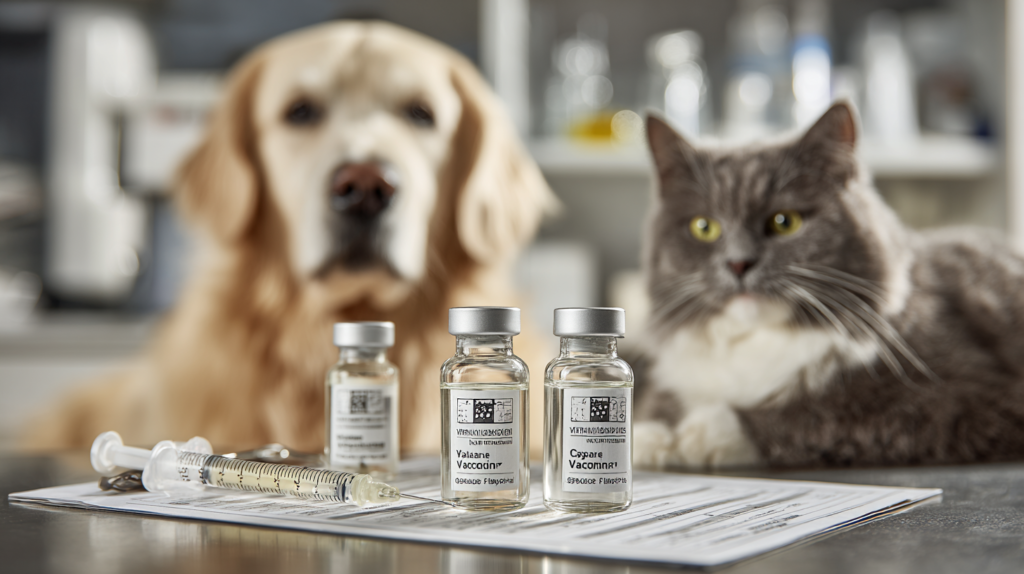Discover the crucial difference between pet core vaccines and non-core vaccines in our comprehensive guide. Learn which vaccines your dog or cat needs for optimal protection and health.
Table of Contents
As a responsible pet parent, ensuring your furry family member receives proper preventative healthcare is crucial—and vaccinations form the cornerstone of this care. But with so many vaccines available, how do you know which ones your pet truly needs? Understanding the difference between pet core vaccines and non-core vaccines can help you make informed decisions about your companion’s health while avoiding unnecessary treatments.
In this comprehensive guide, we’ll explore everything you need to know about pet core vaccines, from what makes them essential to which ones your specific pet requires based on their species, lifestyle, and risk factors.
What Are Pet Core Vaccines?

Core vaccines are immunizations considered vital for all pets of a particular species, regardless of their circumstances, lifestyle, or geographic location. These vaccines protect against diseases that:
- Are particularly severe or life-threatening
- Have widespread distribution
- Pose a risk of infection to all animals
- May be transmissible to humans (zoonotic potential)
In contrast, non-core vaccines are only recommended for pets with specific risk factors, such as geographic location, environment, or lifestyle that increase their exposure to certain diseases.
Dr. Amanda Wilson, veterinary immunologist at Pacific Animal Health Center, explains: “Core vaccines protect against diseases that represent a threat to all pets and potentially public health. They’re the foundation of preventative care that every pet should receive, barring medical contraindications.”
Core Vaccines for Dogs

Rabies Vaccine
The rabies vaccine isn’t just a core vaccine—it’s legally required for dogs in most states across the US.
- Disease information: Rabies is a fatal viral disease affecting the central nervous system, transmissible to humans, and nearly 100% fatal once symptoms appear.
- Vaccination schedule: Initial vaccine at 12-16 weeks of age, booster 1 year later, then every 1-3 years depending on the vaccine type and local regulations.
- Importance: According to the World Health Organization, rabies causes approximately 59,000 human deaths annually worldwide, with dogs being the source of 99% of human infections in countries where the disease is endemic.
Canine Distemper Vaccine
- Disease information: Canine distemper is a highly contagious viral disease affecting respiratory, gastrointestinal, and nervous systems.
- Vaccination schedule: Series of vaccines starting at 6-8 weeks, given every 3-4 weeks until 16 weeks of age, with boosters at 1 year and then every 3 years.
- Importance: Even with treatment, distemper has a mortality rate of approximately 50% in dogs, with survivors often facing lifelong neurological complications.
Canine Parvovirus Vaccine
- Disease information: Parvovirus causes severe, often bloody diarrhea, vomiting, and can rapidly lead to life-threatening dehydration and sepsis.
- Vaccination schedule: Series beginning at 6-8 weeks, every 3-4 weeks until 16 weeks of age, booster at 1 year, then every 3 years.
- Importance: Particularly dangerous for puppies, with mortality rates reaching 91% if left untreated. Even with aggressive treatment, mortality ranges from 5-20%.
Canine Adenovirus (Hepatitis) Vaccine
- Disease information: Canine adenovirus type 1 causes infectious canine hepatitis, affecting the liver, kidneys, and eyes.
- Vaccination schedule: Series starting at 6-8 weeks, every 3-4 weeks until 16 weeks, booster at 1 year, then every 3 years.
- Importance: The disease can cause acute liver failure and death in severe cases, with a mortality rate of 10-30% in untreated dogs.
Core Vaccines for Cats

Rabies Vaccine
- Disease information: As with dogs, rabies poses a serious threat to cats and humans.
- Vaccination schedule: Initial vaccine at 12-16 weeks, booster 1 year later, then annually or every 3 years depending on the vaccine type and local regulations.
- Importance: Indoor cats still require rabies vaccination as bats (major rabies vectors) can enter homes and potentially expose cats to the virus.
Feline Panleukopenia (Distemper) Vaccine
- Disease information: Highly contagious viral disease causing severe gastrointestinal symptoms, fever, and often death, particularly in kittens.
- Vaccination schedule: Series beginning at 6-8 weeks, every 3-4 weeks until 16 weeks, booster at 1 year, then every 3 years.
- Importance: Without treatment, mortality rates exceed 90% in kittens. A 2019 study published in the Journal of Feline Medicine and Surgery found that outbreaks continue to occur even in developed countries.
Feline Herpesvirus-1 (Rhinotracheitis) Vaccine
- Disease information: Causes upper respiratory infection with ocular and nasal discharge, which can become chronic.
- Vaccination schedule: Series starting at 6-8 weeks, every 3-4 weeks until 16 weeks, booster at 1 year, then every 3 years.
- Importance: While rarely fatal in adult cats, this virus causes lifelong infection with periodic reactivation during times of stress.
Feline Calicivirus Vaccine
- Disease information: Another cause of upper respiratory infection in cats, sometimes leading to painful oral ulcers.
- Vaccination schedule: Series starting at 6-8 weeks, every 3-4 weeks until 16 weeks, booster at 1 year, then every 3 years.
- Importance: A study in the Journal of Feline Medicine and Surgery found that calicivirus is responsible for approximately 40% of all feline upper respiratory infections.
Common Non-Core Vaccines for Dogs

Non-core vaccines may be recommended based on your dog’s specific risk factors. Here’s a breakdown of the most common ones:
Bordetella Bronchiseptica (Kennel Cough)
- Recommended for: Dogs that frequent grooming facilities, dog parks, boarding kennels, training classes, or other high-density dog environments.
- Disease information: Causes infectious tracheobronchitis, a highly contagious respiratory infection.
- Vaccination schedule: Typically given annually, though some high-risk dogs may receive it every 6 months.
Leptospirosis
- Recommended for: Dogs with outdoor lifestyles, particularly those with access to wildlife, standing water, or who live in rural or wooded areas.
- Disease information: Bacterial infection that can cause kidney and liver damage; zoonotic to humans.
- Vaccination schedule: Two initial doses 2-4 weeks apart, then annual boosters.
- Regional importance: A 2022 study published in Veterinary Record found leptospirosis cases increasing in urban areas, potentially linked to climate change and growing rat populations.
Canine Influenza (H3N8 and H3N2)
- Recommended for: Dogs in geographic areas with outbreaks or those that frequently interact with other dogs.
- Disease information: Viral respiratory infection causing coughing, nasal discharge, and fever.
- Vaccination schedule: Two initial doses 2-4 weeks apart, then annual boosters.
Lyme Disease
- Recommended for: Dogs in endemic areas (particularly Northeast, Upper Midwest, and Pacific Northwest regions of the US).
- Disease information: Tick-borne bacterial infection affecting joints, kidneys, and other systems.
- Vaccination schedule: Two initial doses 2-4 weeks apart, then annual boosters.
- Geographic consideration: According to the CDC’s 2022 data, Lyme disease cases in dogs serve as sentinels for human risk, with prevalence increasing in previously low-risk areas.
Common Non-Core Vaccines for Cats

Feline Leukemia Virus (FeLV)
- Recommended for: Kittens (as their status may be unknown), outdoor cats, or cats living with FeLV-positive cats.
- Disease information: Retrovirus that suppresses the immune system and can lead to various cancers.
- Vaccination schedule: Two initial doses 3-4 weeks apart, then annual boosters for cats at continued risk.
- Statistical impact: The Cornell Feline Health Center reports that approximately 2-3% of all cats in the United States are infected with FeLV.
Feline Immunodeficiency Virus (FIV)
- Recommended for: Outdoor cats, especially intact males with territorial fighting behaviors.
- Disease information: Retrovirus similar to HIV in humans that progressively weakens the immune system.
- Vaccination schedule: Three initial doses, 2-3 weeks apart, then annual boosters.
- Consideration: This vaccine can cause false-positive results on FIV tests, making it controversial in some veterinary circles.
Chlamydophila Felis
- Recommended for: Cats in multi-cat environments where the disease has been confirmed.
- Disease information: Bacterial infection causing conjunctivitis and upper respiratory symptoms.
- Vaccination schedule: Two initial doses 3-4 weeks apart, then annual boosters if risk continues.
Factors Influencing Vaccination Recommendations
Veterinarians consider several factors when creating a vaccination protocol for your pet:
Age and Life Stage
| Life Stage | Vaccination Considerations |
| Puppies/Kittens | Require series of core vaccines to build immunity; maternal antibodies can interfere with early vaccines |
| Adult Pets | Regular boosters of core vaccines; non-core vaccines based on risk assessment |
| Senior Pets | Continued core vaccines; risk-benefit analysis for non-core vaccines; potential adjustment of protocols for health conditions |
Lifestyle and Environment
Your pet’s daily activities significantly impact their disease exposure risk:
- Indoor-only cats: Still need core vaccines but may need fewer non-core vaccines
- Outdoor pets: Higher risk for various diseases, may need additional non-core vaccines
- Pets that travel: May require specific vaccines based on destination regions
- Social pets: Those frequently around other animals need protection against contagious diseases
Geographic Location
Disease prevalence varies significantly by region:
- Lyme disease: Primarily Northeast, Upper Midwest, and Pacific Northwest
- Leptospirosis: Higher in warm, wet climates and areas with wildlife contact
- Canine influenza: Outbreaks occur sporadically in different regions
- Rattlesnake vaccine: Only relevant in areas where these snakes are present
Health Status
Certain medical conditions may necessitate adjustments to vaccination protocols:
- Immunocompromised pets: May have increased risk from live vaccines
- Chronic illness: May require modified schedules or exemptions
- Previous vaccine reactions: May necessitate pretreatment or alternative protocols
The Science Behind Pet Core Vaccines
Understanding how vaccines work can help pet owners appreciate their importance in preventative healthcare.
How Vaccines Build Immunity
Vaccines work by introducing a modified version of a disease organism (antigen) to your pet’s immune system. This can be:
- Killed (inactivated) vaccines: Contain dead pathogens that cannot cause disease
- Modified live vaccines: Contain weakened pathogens that typically cannot cause disease but stimulate stronger immunity
- Recombinant vaccines: Contain only specific proteins from the pathogen, not the entire organism
When introduced to these antigens, your pet’s immune system:
- Recognizes them as foreign
- Produces antibodies against them
- Creates memory cells that remember how to fight the disease
- Responds rapidly if the actual disease is encountered later
Herd Immunity and Public Health
When a significant percentage of pets are vaccinated, the entire community benefits from “herd immunity”:
- Reduced circulation of pathogens in the animal population
- Protection for pets who cannot be vaccinated due to medical reasons
- Decreased risk of zoonotic diseases transmitting to humans
A 2021 study in Vaccine reported that areas with vaccination rates below 70% for rabies saw increased incidence of the disease in both animal and human populations, highlighting the public health importance of pet core vaccines.
Potential Vaccine Side Effects and Risks
While vaccines are generally safe, understanding potential side effects helps pet owners make informed decisions and recognize when to seek veterinary attention.
Common Minor Side Effects
- Mild lethargy for 24-48 hours
- Temporary soreness at injection site
- Slight fever
- Reduced appetite for 1-2 days
Rare Serious Side Effects
- Allergic reactions (facial swelling, hives, vomiting, diarrhea, collapse)
- Vaccine-associated sarcoma (rare cancer at injection site, primarily in cats)
- Immune-mediated diseases (extremely rare)
Dr. Michelle Torres, veterinary immunologist, puts these risks in perspective: “The risk of serious adverse effects from vaccination is extremely low—generally less than 0.05% of all vaccinations administered. Compare this to the significant morbidity and mortality risks of the diseases we vaccinate against, and the benefit-risk analysis strongly favors vaccination for most pets.”
The Controversy Around Over-Vaccination
Some pet owners and veterinarians have raised concerns about potential over-vaccination. Here’s what the science says:
Duration of Immunity Studies
Research has demonstrated that many pet core vaccines provide protection for longer than previously thought:
- Many core vaccines now have demonstrated immunity duration of 3+ years
- This has led to extended vaccination intervals for many adult pets
- Antibody titer testing can sometimes be used to determine if revaccination is needed
Vaccine Guidelines Evolution
Major veterinary organizations regularly update their vaccination guidelines based on emerging research:
- The American Animal Hospital Association (AAHA) and the American Association of Feline Practitioners (AAFP) provide evidence-based vaccination guidelines
- These guidelines have shifted toward more individualized protocols rather than one-size-fits-all approaches
- The concept of core vs. non-core vaccines helps veterinarians tailor recommendations
Antibody Titer Testing
Titer testing measures antibody levels to assess immunity:
- Can sometimes be used instead of automatic revaccination
- Most commonly used for distemper and parvovirus in dogs
- More expensive than vaccination
- Not universally accepted as a replacement for vaccination schedules
Creating a Personalized Vaccination Schedule with Your Veterinarian
Developing an appropriate vaccination protocol for your pet involves partnership with your veterinarian.
Questions to Discuss with Your Vet
- Which core vaccines does my pet need based on species and age?
- Which non-core vaccines are recommended based on our specific situation?
- Are there any vaccines my pet should avoid due to health status or previous reactions?
- What is the appropriate timing and frequency for boosters?
- Would titer testing be appropriate for my pet instead of automatic revaccination?
Sample Vaccination Schedule for Dogs
| Age/Stage | Core Vaccines | Potential Non-Core Vaccines Based on Risk |
| 6-8 weeks | Distemper, Parvovirus, Adenovirus (first dose) | Bordetella if entering puppy classes |
| 10-12 weeks | Distemper, Parvovirus, Adenovirus (second dose) | Leptospirosis (first dose), Lyme in endemic areas |
| 14-16 weeks | Distemper, Parvovirus, Adenovirus (third dose), Rabies (first dose) | Leptospirosis (second dose), Canine influenza if in outbreak area |
| 1 year | Distemper, Parvovirus, Adenovirus, Rabies boosters | Non-core boosters as needed |
| Adult (1+ years) | Core boosters every 3 years (or as legally required for rabies) | Annual or biannual non-core boosters as needed |
Sample Vaccination Schedule for Cats
| Age/Stage | Core Vaccines | Potential Non-Core Vaccines Based on Risk |
| 6-8 weeks | FVRCP (Panleukopenia, Herpesvirus, Calicivirus) first dose | FeLV if kitten will have outdoor access |
| 10-12 weeks | FVRCP second dose | FeLV second dose if needed |
| 14-16 weeks | FVRCP third dose, Rabies first dose | FIV if high-risk lifestyle |
| 1 year | FVRCP booster, Rabies booster | Non-core boosters as needed |
| Adult (1+ years) | Core boosters every 3 years (or as legally required for rabies) | Annual non-core boosters if risk continues |
Special Vaccination Considerations
Vaccination for Senior Pets
Older pets still need protection from infectious diseases, but considerations may include:
- Pre-vaccination bloodwork to ensure organ function
- Splitting vaccines rather than giving multiple at once
- Potential extension of intervals between boosters
- Risk-benefit analysis for non-core vaccines
Rescue and Shelter Animals
Animals with unknown vaccination histories present special challenges:
- Often receive “blanket” vaccination upon intake
- May need full series of core vaccines regardless of age
- Higher priority for certain non-core vaccines due to group housing risk
- Stress management is important as stress can reduce vaccine efficacy
Breeding Animals
Breeding dogs and cats have unique vaccination needs:
- Females should be vaccinated before breeding, not during pregnancy
- Adequate maternal antibody transfer requires good vaccination status
- Puppies and kittens from well-vaccinated mothers may need adjusted vaccination schedules
Cost vs. Benefit Analysis of Vaccination
The financial aspect of pet healthcare is a practical consideration for many owners. Let’s break down the economics:
Preventative Care Economics
| Consideration | Cost Estimate | Notes |
| Core Vaccine Series (Puppy/Kitten) | $75-150 | Multiple visits, includes exam fees |
| Annual Adult Vaccines | $45-100 | Core and selected non-core |
| Treatment for Parvovirus | $1,500-3,000+ | Hospitalization required |
| Treatment for Distemper | $2,500-5,000+ | Poor prognosis even with treatment |
| Treatment for Rabies | Not possible | Fatal once symptoms appear |
These figures highlight why preventative care through pet core vaccines is not just medically sound but economically advantageous as well.
Pet Insurance and Vaccination
Most pet insurance policies:
- Cover treatment for vaccine-preventable diseases if the pet was not appropriately vaccinated
- Some plans offer wellness coverage that includes vaccination costs
- Often require proof of core vaccinations to maintain coverage
Legal Requirements and Travel Considerations
State and Local Vaccination Laws
Legal requirements typically focus on rabies vaccination:
- Most states mandate rabies vaccines for dogs, cats, and sometimes ferrets
- Documentation requirements and intervals vary by jurisdiction
- Some municipalities require proof of vaccination for licensing
- Non-compliance can result in fines or legal liability if your pet transmits disease
International and Interstate Travel
If traveling with your pet:
- International travel requires health certificates and specific vaccinations
- Requirements vary significantly by country
- Most countries require rabies vaccination at minimum
- Some countries require antibody titer testing to prove immunity
- Interstate travel within the US generally requires current rabies vaccination
Visual Guide to Core vs. Non-Core Vaccines
Real-World Case Studies
Case Study 1: Parvovirus Outbreak in an Undervaccinated Community
In 2023, a rural community in the Midwest experienced a severe parvovirus outbreak affecting over 60 dogs. Investigation revealed local vaccination rates had fallen below 40% due to misinformation about vaccine safety.
- 75% of unvaccinated dogs exposed to the virus became clinically ill
- 35% of those ill dogs died despite treatment
- 0% of properly vaccinated dogs developed clinical disease
This outbreak demonstrates the critical importance of maintaining high community vaccination rates with pet core vaccines.
Case Study 2: Indoor Cat with Unexpected FeLV Exposure
Maya, an 8-year-old indoor-only cat, had received core vaccines but not FeLV vaccination due to her presumed low risk. When her owner temporarily fostered a stray kitten that tested positive for FeLV, Maya was tested and found to have contracted the virus.
This case illustrates how circumstances can change unexpectedly, exposing pets to diseases their owners hadn’t anticipated—underscoring why some veterinarians recommend broader vaccination even for seemingly low-risk pets.
Future of Pet Vaccination
Vaccination science continues to evolve, with several exciting developments on the horizon:
Emerging Technologies
- mRNA vaccines: Following human COVID-19 vaccine success, research into veterinary applications is underway
- Oral and transdermal vaccines: Less invasive administration methods
- Extended duration vaccines: Formulations that may provide even longer immunity periods
- Marker vaccines: Allow differentiation between infected and vaccinated animals
Personalized Medicine Approaches
The future likely holds more individualized approaches:
- Genetic testing to identify pets at higher risk for specific diseases
- Advanced titer testing becoming more affordable and accessible
- Tailored vaccination schedules based on detailed risk analysis
- Better duration of immunity data for non-core vaccines
For more expert pet care tips and product recommendations, visit BlithePet.com — your trusted source for pet wellness.
Frequently Asked Questions About Pet Vaccines
Q: Can my pet receive multiple vaccines during one visit?
A: Yes, most healthy pets can safely receive multiple vaccines in one visit. However, if your pet has a history of vaccine reactions, your veterinarian might recommend spreading them out across multiple appointments.
Q: Are vaccine reactions common in pets?
A: Serious vaccine reactions are rare, occurring in less than 0.5% of vaccinated pets. Mild reactions like slight lethargy or soreness at the injection site are more common but typically resolve within 24-48 hours without treatment.
Q: If my cat never goes outside, does it still need vaccines?
A: Yes, indoor cats still need core vaccines. Diseases like rabies can affect indoor cats if a bat enters the home, and viruses like feline herpesvirus can be brought in on owners’ clothing or through screens.
Q: Can older pets skip vaccinations?
A: Senior pets generally still need core vaccines, as age itself does not confer immunity. However, vaccination intervals might be adjusted based on health status and risk factors.
Q: Is it dangerous to give a pet too many vaccines?
A: Current veterinary guidelines are designed to provide necessary protection while avoiding over-vaccination. Following AAHA and AAFP recommendations for pet core vaccines and individualized non-core vaccine selections helps strike the appropriate balance.
Q: Can I vaccinate my pet myself to save money?
A: While some vaccines are available at feed stores, self-vaccination is not recommended. Professional administration ensures proper handling, storage, and administration technique. Additionally, many vaccines (including rabies) are only legally recognized when administered by a licensed veterinarian.
Conclusion: Making Informed Vaccination Decisions
Vaccination remains one of the most important preventative healthcare measures for pets. Core vaccines provide essential protection against diseases that threaten every dog and cat, while non-core vaccines offer additional protection based on individual risk factors.
By working closely with your veterinarian to create a tailored vaccination protocol, you’re making a powerful investment in your pet’s long-term health and wellbeing. Remember that vaccination protocols may need adjustment throughout your pet’s life as circumstances, health status, and vaccine technologies evolve.
Have a similar experience with your pet’s vaccination journey? Share it in the comments below!







